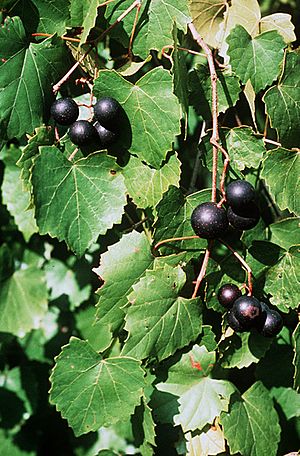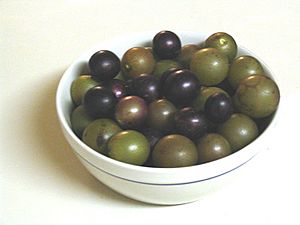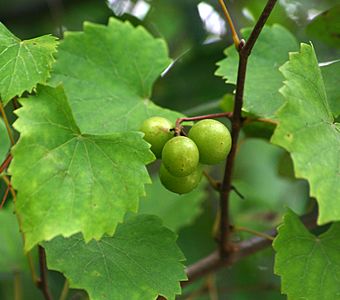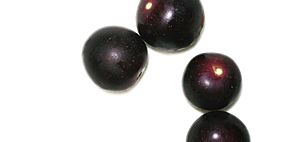Muscadine facts for kids
Quick facts for kids Muscadine |
|
|---|---|
 |
|
| Scientific classification | |
| Kingdom: | |
| (unranked): | |
| (unranked): | |
| (unranked): | |
| Order: | |
| Family: | |
| Genus: | |
| Subgenus: |
Muscadinia
|
| Species: |
V. rotundifolia
|
| Binomial name | |
| Vitis rotundifolia |
|
Muscadine (also called Vitis rotundifolia) is a type of grapevine. It grows naturally in the southeastern and south-central parts of the United States. You can find it from Florida all the way up to the New Jersey coast, and west to eastern Texas and Oklahoma. People have been growing these grapes since the 1500s!
Muscadine plants love warm and humid weather. They don't need as much cold as other grape types. They grow very well in the summer heat.
When muscadine berries are ripe, they can be bronze, dark purple, or black. Wild types might even stay green. People often use muscadines to make wine, juice, and jelly. These grapes are also full of healthy things called polyphenols.
In nature, muscadine vines provide a home for many animals. They offer shelter, food, and leaves for birds and other creatures. They are also a food source for the caterpillars of the Nessus Sphinx Moth and the Mournful Sphinx Moth.
Contents
About Muscadine Grapes
Muscadine grapes belong to the same Vitis family as other grape species. However, they are in their own special group called Muscadinia. All other grape species are in the Euvitis group.
Scientists sometimes divide the muscadine species into three main types. These are found in different parts of the Americas. Some experts even think muscadines should be a completely separate group of plants.
Muscadine grapes have 40 chromosomes, while most other grapes have 38. This difference means they usually can't mix and create new types easily. However, a few special mixes have been made. One example is the 'Southern Home' grape.
Muscadines are strong grapes with tough skins. This helps protect them from many plant diseases. But they can still be affected by tiny worms called nematodes.
Types of Muscadine Grapes
There are about 152 different types, or cultivars, of muscadine grapes grown in the Southern states. These include bronze, black, and red varieties. Some are common grapes, while others are special patented types.
Many muscadine types need another plant to help them make fruit. This is because they only have female parts. But some types, like 'Carlos' and 'Noble', have both male and female parts. They can make fruit on their own and also help other muscadine plants.
Sometimes, muscadine grapes might not produce many berries. Their berries can also be small, or have a flavor or thick skin that people don't like. Some types are grown mainly for eating fresh. These need to be large, sweet, and have thinner skins. Other types are grown for making wine, juice, or jelly. These need to produce a lot of berries that are sweet and have good color.
Some popular types for eating fresh include Black Beauty, Fry, Ison, James, and Scuppernong. The 'Southern Home' type was created by the University of Florida. It is a mix of muscadine and other grape types.
Muscadine plants can start producing grapes in 3 to 5 years. A single field can produce a lot of grapes, sometimes 20 to 45 tonnes per hectare. Muscadines grow best in rich, sandy soils. They grow wild in well-drained areas that don't get too dry or too wet.
They are also very good at resisting pests and diseases. This includes a serious grape disease called Pierce's disease. Muscadine is also very resistant to Phylloxera, a tiny insect that can kill the roots of other grapevines.
Where Muscadine Wine is Made

Muscadine wines are made in many places. These include:
- United States (as a country)
- Alabama
- Arkansas
- Florida
- Georgia
- Louisiana
- Mississippi
- North Carolina
- South Carolina
- Tennessee
- Texas
- Virginia
Muscadine Nutrients
Here's what 100 grams of muscadine grapes contain, according to the USDA:
- Energy: 57 kilocalories
- Fats: 0.47 grams
- Carbohydrates: 13.93 grams
- Dietary Fiber: 3.9 grams
- Protein: 0.81 grams
- Calcium: 37 milligrams
- Phosphorus: 24 milligrams
- Potassium: 203 milligrams
- Sodium: 1 milligram
- Vitamin C: 6.5 milligrams
- Riboflavin: 1.5 milligrams
Healthy Compounds in Muscadines

Muscadine grapes are known for their thick, colorful skins. These skins are rich in healthy compounds called polyphenols. Scientists are very interested in studying these compounds.
Some early studies suggested muscadines had a lot of resveratrol. However, later research found little to no resveratrol in these grapes.
Other healthy polyphenols found in muscadines include:
- Anthocyanins (which give them color)
- Tannins
- Quercetin
- Flavan-3-ols (especially in the seeds)
- Gallic acid
- Ellagic acid (especially in the skin)
- Myricetin (especially in the leaves)
- Kaempferol
The most polyphenols are found in the seeds of the muscadine grape. The skins have the next highest amount, followed by the leaves, and then the pulp (the fleshy part of the grape).
Images for kids
See also
 In Spanish: Vitis rotundifolia para niños
In Spanish: Vitis rotundifolia para niños



